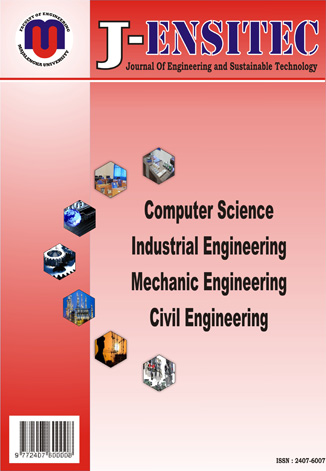ANALISA HASIL UJI KOMPRESOR SISTEM REFRIGERASI MENGGUNAKAN INVERTER
DOI:
https://doi.org/10.31949/jensitec.v10i01.7616Abstrak
One of the largest uses of electrical energy is electrical energy used in air conditioning. Electrical power consumption for air conditioning has a figure of about 50-60% of the total electrical energy consumption of a building. In the industrial world, air conditioning or refrigeration systems are used to maintain the temperature conditions of raw materials or products produced with the intention of extending storage life through the cooling process. Refrigeration systems use compressor motors as a medium to circulate refrigerant throughout the system. This study aims to compare three parameters in a refrigeration system that uses an inverter on its compressor motor compared to a conventional refrigeration system. The three parameters are electrical power, cooling capacity and COP (Coefficient of performance). The research was conducted using an analysis-based method of existing systems. Data collection was carried out twice in steady conditions. The results of this study obtained the following data: The use of inverters in refrigeration compressors decreased electrical power by 18.3% increased COP in refrigeration systems by 44.1% and increased cooling capacity by 31.2%.
Kata Kunci:
Inverter, Compressor, Refrigeration System, Electric PowerUnduhan
Referensi
Anderson, L. E. (2021). Pengukuran dan Mitigasi Global Warming Potential di Industri. Jurnal Teknologi Lingkungan, 18(2), 210-225.
ASHRAE. (2006). ASHRAE Handbook of Refrigeration. American Society Heating, Refrigerating, and Air Conditioning Engineers.
Dossat, Roy J. (1981). Principles of Refrigeration. Second Edition. SI Version. Canada: John Wiley and Sons, Inc.
Holman, J.P. (2010). Heat Transfer. Tenth Edition. New York: McGraw-Hill.
Stoecker W.F., dan Jerold W.J. (1983). Refrigeration and Air Conditioning. Second Edition. New York: McGraw-Hill
Smith, J. A. (2019). Peran Manusia dalam Pemanasan Global: Tantangan dan Solusi. Jurnal Konservasi Lingkungan, 12(3), 78-90.
Diterbitkan
Cara Mengutip
Terbitan
Bagian
Lisensi
Hak Cipta (c) 2023 Nia Nuraeni Suryaman, Eki Riyandi Noordianto

Artikel ini berlisensiCreative Commons Attribution-ShareAlike 4.0 International License.
An author who publishes in the J-ENSITEC (Journal of Engineering and Sustainable Technology) agrees to the following terms:
- Author retains the copyright and grants the journal the right of first publication of the work simultaneously licensed under the Creative Commons Attribution-ShareAlike 4.0 License that allows others to share the work with an acknowledgment of the work's authorship and initial publication in this journal
- The author is able to enter into separate, additional contractual arrangements for the non-exclusive distribution of the journal's published version of the work (e.g., post it to an institutional repository or publish it in a book) with the acknowledgment of its initial publication in this journal.
- The author is permitted and encouraged to post his/her work online (e.g., in institutional repositories or on their website) prior to and during the submission process, as it can lead to productive exchanges, as well as earlier and greater citation of the published work







